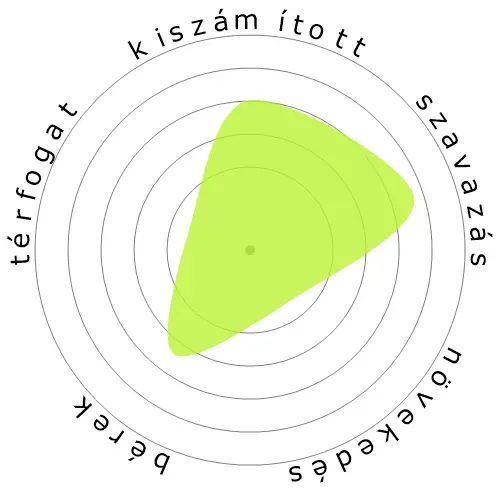Kereskedelmi és ipari tervezők




Az emberek ezt is megtekintették
Számított automatizálási kockázat
Közepes kockázat (41-60%): A közepes automatizálási kockázattal járó foglalkozások általában rutinszerű feladatokat tartalmaznak, de még mindig szükség van némi emberi ítélőképességre és interakcióra.
További információ arról, hogy mi ez a pontszám, és hogyan számítják ki, elérhető itt.
Felhasználói szavazás
A látogatóink szerint alacsony az esélye annak, hogy ezt a foglalkozást automatizálni fogják. Ezt az értékelést tovább erősíti a kiszámított automatizálási kockázati szint, amely 47% esélyt becsül az automatizálásra.
Mit gondol, milyen kockázatai vannak az automatizációnak?
Milyen valószínűséggel fogják Kereskedelmi és ipari tervezők robotok vagy mesterséges intelligencia helyettesíteni a következő 20 évben?
Érzelem
A következő grafikon mindenhol szerepel, ahol jelentős mennyiségű szavazat áll rendelkezésre, hogy értelmes adatokat lehessen megjeleníteni. Ezek a vizuális ábrázolások az időbeli felhasználói szavazási eredményeket mutatják, jelentős jelzést adva a hangulat trendjeiről.
Érzelem az időben (évente)
Növekedés
A(z) 'Commercial and Industrial Designers' munkahelyi nyitások száma várhatóan 3,1%-kal nő 2033-ra.
Teljes foglalkoztatottság és becsült állásnyitások
A frissített előrejelzések 09-2025 időpontban esedékesek..
Bérek
A(z) 2023-ban a 'Commercial and Industrial Designers' éves középfizetése 76 250 $ volt, vagyis 36 $ óránként.
'Commercial and Industrial Designers' magasabb összeget kaptak, mint az országos mediánbér, ami 48 060 $-n állt.
Bérek az idők folyamán
Térfogat
2023 időpontjában 30 810 ember dolgozott 'Commercial and Industrial Designers' munkakörben az Egyesült Államokban.
Ez körülbelül a < 0,001% -át képviseli az országban foglalkoztatott munkaerőnek.
Másképp fogalmazva, körülbelül minden 4 ezer. ember 'Commercial and Industrial Designers'-ként dolgozik.
Munkaköri leírás
Tervezze és fejlessze ki a gyártott termékeket, mint például autók, háztartási gépek és gyermekjátékok. Kombinálja művészi tehetségét a termékhasználat, marketing és anyagok kutatásával, hogy létrehozza a legfunkcionálisabb és legvonzóbb terméktervezést.
SOC Code: 27-1021.00


Megjegyzések
Leave a comment
Of course, modern designers work in a multidisciplinary manner and communicate between the various fields of product development. They are not as isolated as the qualities listed above suggest, so I doubt they will become extinct too quickly.
Companies are unlikely to risk their money and reputation on AI wild shots without some form of sentient consideration. Despite this, I bet some will try it anyway, and I am honestly eager to see them succeed.
Advanced creative tasks like innovation management and the expansion of the product portfolio are too important for companies to leave exclusively to tools right now. This job will likely adapt and merge a lot more with engineering and management disciplines.
It is normal for jobs to change with technology.
However, the human-like quality of AI, like Chat GPT3 and others, is still primitive in capacity, even though their articulation is top-notch, to say the least. Even then, it is not enough to design products at the capacity that humans currently are capable of.
Certain design fields will probably struggle to reduce their dependency on humans, like graphic design, illustrations, and animation design. However, fields like product or industrial design, architecture, and the like are not likely to be replaced any time soon.
For now and in the foreseeable future, I see AI as a personal assistant to industrial designers rather than a threat.
Given a certain prompt and a starting image, an AI could create thousands of designs, each better than the last one.
New CAD tools will optimize and speed up the development process. Consequently, companies will hire fewer employees and expect more from them. This could lead to worker burnout and exploitation becoming even more common, due to the limited staff.
Prospective employees, in addition to having exceptional artistic skills, will also be expected to have proficiency in programming.
In English or Spanish I think it is not understood that it is a profession that has many factors that it is difficult to generate algorithms, art in my opinion is the last line of algorithms, industrial design contemplates Sciences and arts. As logical as that anyone can have a proposal to many requirements in the industry.
In my humble opinion, it falls under creative technology. It doesn't matter what you are actually designing; you're always going to, in the end, design a new way of living.
Hagyjon egy választ erről a foglalkozásról